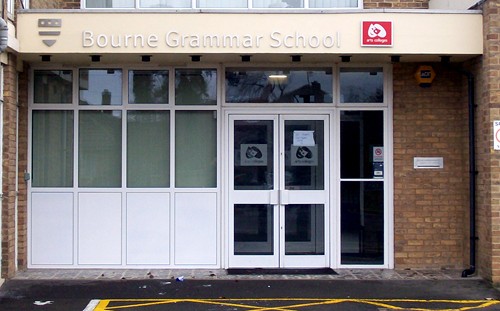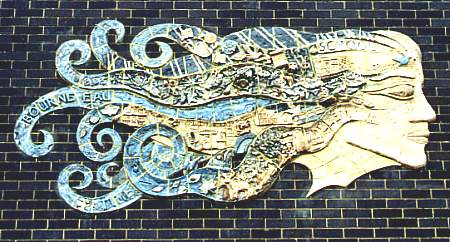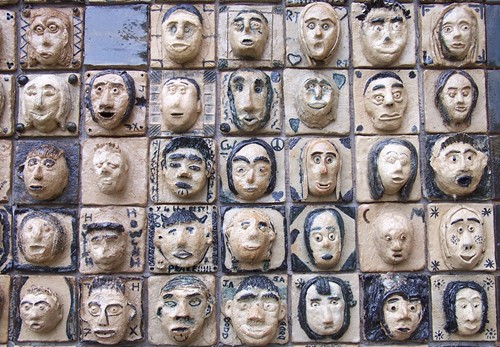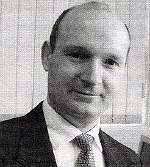|
A grammar school
has existed in Bourne since the 14th century but very little is known about this early establishment other than that Sir John Fisher was appointed master in 1330. Where the school premises were and how many pupils were taught there over the years is not recorded. Our only evidence today of such an educational facility is the Old Grammar School building that still stands in the churchyard next to the Abbey Church but this was not built until 1678 when it was known as the Free Grammar School of King Charles in the Town of Bourn. It was financed by William Trollope, a local landowner, who left a bequest in 1636 that provided for an endowment of £30 a year to maintain "an honest, learned, and godly schoolmaster" and even then, the premises that we see now have been largely rebuilt since his day. There was great concern over its disappearance and in the years that followed there were several attempts to revive it but it was almost twenty years before those who worked so hard for the restoration of secondary education in the town were eventually rewarded and when the First World War ended, it was resuscitated as a co-educational secondary school. Bequests from two charities founded by Robert Harrington (1654) and that from William Trollope (1636) were united to form a single foundation called the Harrington and Trollope Secondary School and this money was supplemented by an annual grant from Kesteven County Council to meet the fees of those who had secured free places while parental fees were required in respect of the other pupils. Building work was undertaken to modernise the premises and to provide additional accommodation to keep pace with the increasing number of pupils. Major extensions were opened in 1961 to provide a new block with a main assembly hall and gymnasium, science laboratories and a library while the playing fields were extended by the incorporation of adjacent meadow land on the north side and further classrooms, a dining hall and another laboratory were added soon afterwards. Modernisation and extensions continued and by 1970 the school was sufficiently well established to withstand outside pressure for change. The Labour government's abolition of school selection at the age of 11 plus heralded the introduction of comprehensive education throughout Britain and although many county education authorities favoured the new system, there was a sufficient head of steam in the town to avert reorganisation and so Bourne Grammar School survived.
A new self-contained multi-purpose teaching block was opened in the autumn of 2001 at a cost of £1.1 million and containing classrooms for languages, music and art. Then in the autumn of 2004, a further two-storey extension was opened at a cost of £1 million, providing a library and a learning resources centre equipped with 25 computers. The development also meant that ten mobile classrooms on site that had provided temporary teaching space could finally be phased out, much to the relief of pupils and staff. Dr Stuart Miles, who had been head teacher since January 1998, left the school in the summer of 2004. He had been off for five months the previous year after suffering serious injuries in a car crash and in July 2004, the governors issued a statement saying that he had resigned on health grounds with effect from August 31st. Since his arrival, BGS had been consistently ranked among the top performing schools in the country’s national league tables. An Ofsted report earlier in 2004 praised him for his clear vision and leadership and the school’s high quality of education and pupil achievement. Peter Cookson, a senior teacher at the school, was appointed acting head in his place and in November 2004, a new head teacher was appointed, Jonathan Maddox, aged 39, who took up his duties in January 2005. By this time, the school had expanded considerably with more than 1,000 pupils and a budget of £3.2 million a year. Tradition remains a strong and potent force in the life of Bourne Grammar that maintains high standards of both attainment and behaviour. Speech Day has been an annual event from the start of the Harrington and Trollope school, held then in the Corn Exchange which was large enough for the gathering of pupils, parents and guests and the speeches and prize-giving were always accompanied by some entertainment and invariably ended with the school song, Forty Years On, shared with Harrow School and many others around the country and well embedded in the traditions from its early days.
But there was eventually widespread feeling that its predominantly masculine, sporting theme was no longer relevant in the changing climate and so a new one was chosen. In the summer of 2005, the new head teacher, Jonathan Maddox (see box below) proposed that the school should bid for specialist status to become a centre for the performing arts such as music, drama and English by the year 2007. This would make it eligible for additional resources but first the school had to raise £50,000 to support the application. A local company, Delaine Buses, pledged £5,000 to launch the fund to finance an arts centre which would also be used by other schools and further support to raise the remaining amount was sought from other businesses and parents in time for the bid to be submitted in October 2006. “The performing arts are strong subjects at the school yet drama currently has no specialist teaching place”, explained Mr Maddox. “The generous contribution from Delaine Buses has got us off to a magnificent start.” The funding was achieved the following year and status as a Specialist School in the Performing Arts took effect from the autumn term which began in September 2007 with extra funding totalling more than £600,000 over a four-year period. The money will go towards a variety of different projects including a new drama studio and to celebrate the event a benefit concert was held on Friday 14th September featuring music, dance and drama, to showcase the talents of pupils for the community. Gill Hall, director of Performing Arts specialism at the school, explained: "The intention is to enhance and build on the success the school already achieves in developing the skills of students and to build stronger links within the community and partner schools." In March 2011, the school announced its intention
to apply for academy status. The head teacher, Jonathan Maddox, said that the
benefits would be tremendous including more money and greater independence. But
the move was opposed by Bourne United Charities which owns part of the South
Road site, a situation that has existed since the school was opened in 1921 when
financial aid was granted through the Harrington and Trollope Secondary School
Foundation which they administer. But in June, BUC trustees withdrew their objections after taking legal advice, so enabling the school to proceed with its application. A spokesman said that they had been given assurances about the future ownership of their land at the school site and that the name of Bourne Grammar School would remain unchanged as would the system of selecting pupils on ability. The original target deadline of September 1st was missed by the delay but academy status was finally granted from Sunday 1st January 2012. Mr Maddox told The Local newspaper (6th January 2012): "We are now fully in control of our destiny. We feel confident to take on, embrace and to surmount the challenges ahead, remaining as determined as before to ensure and to strengthen our position as one of the top performing schools in the East of England. Our prominent success over many years is in no small part due to the strength of governance, a strength which gives the governors confidence to take on the additional challenges that fall to them as academy trustees and company directors." The name of the school and the uniforms are to remain unchanged. In July 2012, the school was awarded a grant of £762,000 from the Academies Capital Grant Fund to finance a major building programme to cater for a greater number of pupils. The work began during the summer and continued throughout the year as part of the school's plans to cater for an additional 150 pupils over the next five years. It included the addition of four new classrooms and the enlargement of the existing suite of English and history classrooms. A new block was also added to house a systems and control department where next generation electronics and design technology will be taught and the existing library was also moved to a more central location. The extensions were completed by February 2013 when the school announced that it was now able to accept all prospective pupils for the first time. Over 200 letters of acceptance had been sent out to boys and girls who passed the 11-plus examination and opted for the school as their first choice whereas in the past many have been turned away because of a cap on intake. Headteacher Jonathan Maddox told The Local newspaper (March 1st) that this would be the format in the future. “It is the government’s intention that successful schools should be able to grow to take as many pupils that want to go there”, he said. “We have now got plenty of accommodation to house everyone that wants to come here. We are not forcing anyone to come here. It is the choice of parents and pupils but we are now in a position to offer everyone a place, which is good news.” The new computer block was named the Turing Centre after the computer scientist Alan Turing and the facility was officially opened by the Duke of Edinburgh in April 2013. A newly refurbished geography department was opened in September 2013 after a £50,000 improvement scheme had been carried out during the summer holiday. It consists of a suite of three classrooms with a modern floor to ceiling gallery space for teaching aids and was installed after the school recorded a significant rise in the number of pupils studying the subject at GCSE level and A level. "We aim to be at the forefront of education in every subject we offer and are constantly seeking to improve our facilities", said Mr Maddox. "The new classrooms will provide a spacious and modern learning environment and demonstrate our commitment to this continuing aim."
REVISED SEPTEMBER 2013 See also Early days at Bourne Grammar School Charles Pask Matthews Reginald Foster Bourne United Charities statement on academy status The Duke of Edinburgh's visit in 2013
Go to: Main Index Villages Index |
|||||||||||||



